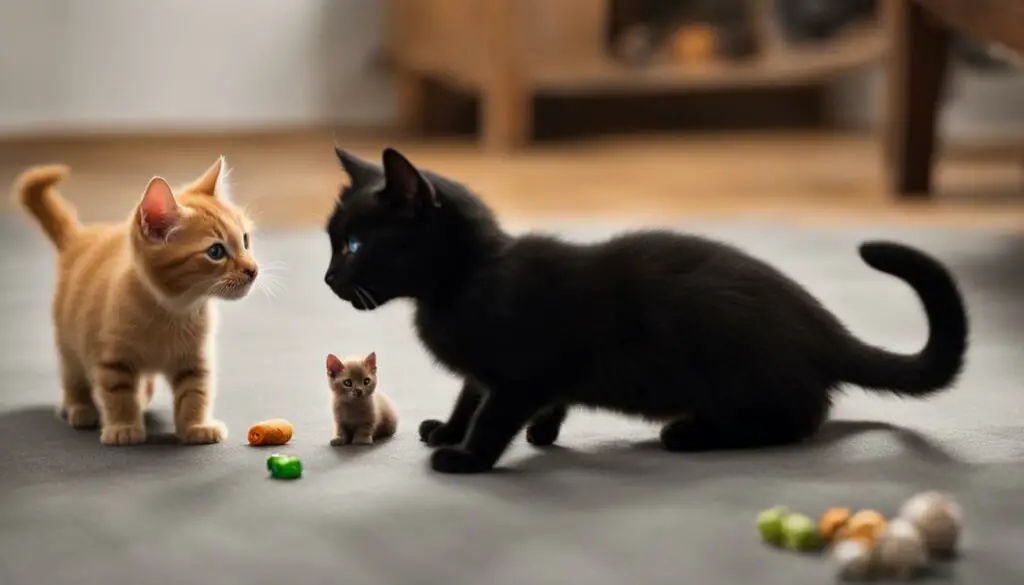Cats are fascinating creatures with unique ways of communicating their emotions. One such behavior is hissing, which can be quite unsettling, especially when directed at a harmless kitten. But why does your cat hiss at the new addition without actually attacking?
It’s important to remember that hissing is a normal behavior for cats and serves as a warning signal. In the case of hissing at kittens, there are a few potential reasons behind this behavior:
- Territorial Instincts: Cats are naturally territorial, and the introduction of a new kitten can disrupt their established boundaries. Hissing at the kitten is a way for your cat to assert their dominance and protect their territory.
- Establishing Hierarchy: Cats have a social structure that relies on a hierarchy. Hissing at the kitten is a way for your cat to establish their position and ensure that the newcomer understands the pecking order.
- Feeling Trapped: The presence of a new kitten can sometimes make your cat feel overwhelmed or trapped. Hissing may be their way of expressing discomfort and the need for personal space.
Understanding these underlying reasons can help you create a more harmonious environment for both your cat and the new kitten. With proper introductions, patience, and a few helpful strategies, you can help your cat adjust and minimize their hissing behavior.
Key Takeaways:
- Hissing is a normal behavior for cats and serves as a warning signal.
- Cats may hiss at kittens due to territorial instincts, establishing hierarchy, or feeling trapped.
- Understanding the reasons behind the hissing can help create a peaceful cohabitation between your cat and the new kitten.
- Proper introductions, giving each cat their own space, and gradual socialization can help alleviate hissing behavior.
- If hissing persists or escalates, seeking professional advice from an animal behaviorist is recommended.
Why Do Cats Hiss in the First Place?
When it comes to cat behavior, hissing is a common vocalization that cats use to communicate a range of emotions. But why do cats hiss in the first place? Understanding the reasons behind their hissing can help us interpret their body language and respond appropriately.
Cats hiss to express various emotions, such as annoyance, pain, or feeling threatened. Hissing is their way of warning others to back off and give them space. It’s also a display of their sharp teeth as a potential threat. By hissing, cats are trying to communicate their discomfort or the need for distance.
As cat owners, it’s essential to pay attention to our furry friends’ body language and vocalizations. By doing so, we can better understand their hissing and determine if it’s due to fear, stress, or another underlying cause. This understanding allows us to provide a calming and supportive environment for our cats.
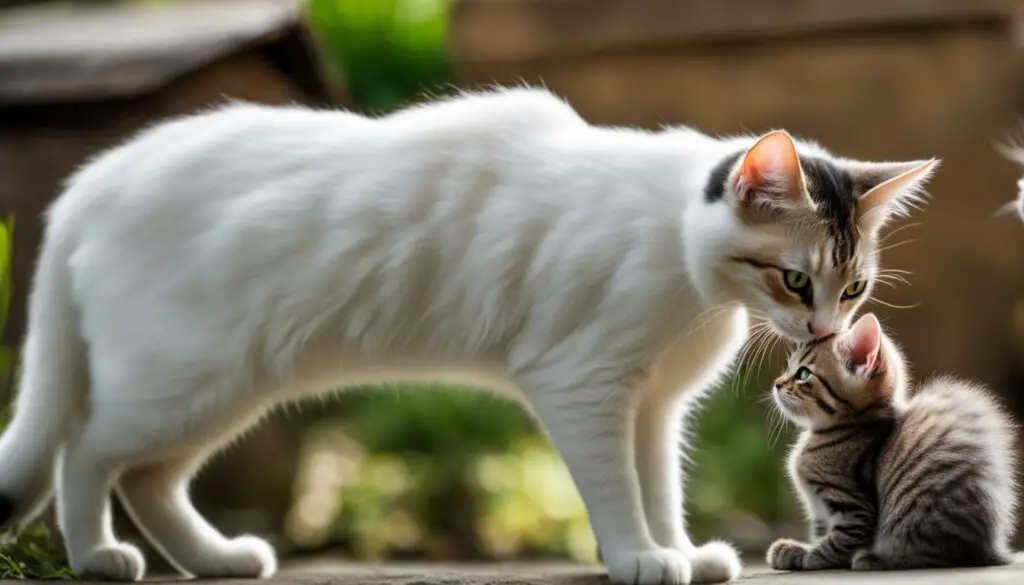
Remember, cats have their own unique personalities, and their hissing behavior can vary from one cat to another. So, if your cat hisses, it’s crucial to assess the situation and respond accordingly. By respecting their boundaries and giving them the space they need, we can foster a harmonious relationship with our feline companions.
Why Is My Cat Hissing at My New Kitten?
Introducing a new kitten to your household can be an exciting and heartwarming experience. However, it’s not uncommon for your older cat to hiss at the new addition, leaving you wondering why this behavior is happening. Understanding the reasons behind your cat’s hissing can help you address the situation effectively and ensure a smooth introduction between your cat and the new kitten.
One of the primary reasons your cat may hiss at the new kitten is due to territorial instincts. Cats are naturally territorial creatures and view their environment as their own. When a new kitten enters their established territory, your cat may feel threatened and hiss as a way to establish boundaries and protect their space.
Additionally, your cat may hiss as a means of establishing hierarchy with the new kitten. Cats have a social structure and a pecking order, and by hissing, your cat is communicating their dominance and trying to establish their position in the household. This behavior is a natural part of their instincts and should subside as the cats adjust to each other’s presence and establish a new dynamic.
What Should I Do if My Cat Starts Hissing at My Kitten?
When your cat starts hissing at your new kitten, it’s important to take appropriate steps to ensure their safety and well-being. Here are some cat introduction tips to help you manage the situation:
- Provide separate spaces: Create a safe and comfortable space for each cat with their own bed, litter box, food, and water bowls. This allows them to establish their territories and reduces the likelihood of territorial aggression.
- Gradual introductions: Start by allowing the cats to sniff each other’s scents through a closed door or using a baby gate. Gradually increase their interactions under supervision, allowing them to get used to each other’s presence.
- Positive reinforcement: Reward calm and friendly behavior with treats, verbal praise, or playtime. This helps create positive associations between the cats and encourages them to form a bond.
- Monitor interactions: While some hissing and growling may be expected during the introduction phase, closely monitor their interactions. If the hissing escalates into aggressive behavior, intervene and separate them to prevent any harm.
Remember, each cat is unique, and the time it takes for them to get used to each other may vary. Patience and consistency are key during the introduction process. If the hissing persists or becomes harmful, it’s advisable to seek professional advice from an animal behaviorist.

Expert Tip: Understanding Cat Territorial Behavior
“When cats hiss at each other, it’s often a way of communicating boundaries and asserting dominance. Territorial aggression is a common behavior, especially when a new kitten is introduced. By providing separate spaces and allowing gradual introductions, you can help your cats establish a comfortable relationship over time.”
– Dr. Samantha Adams, Animal Behaviorist
Cat Socialization Techniques: Helping Your Cat Adjust to a New Kitten
Introducing a new kitten to your older cat can be an exciting time, but it’s important to understand that cats need time to adjust to each other’s presence. By using proper socialization techniques, you can help create a smooth transition and foster a harmonious relationship between your cats.
Gradual Introduction and Supervised Interactions
When bringing a new kitten home, it’s crucial to introduce them to your older cat gradually. Start by keeping the kitten in a separate room with all necessary resources, such as food, water, litter box, and toys. This allows both cats to become familiar with each other’s scents without direct contact. After a few days, begin supervised interactions by allowing them to see each other through a baby gate or cracked door. Gradually increase their exposure to each other while closely monitoring their behavior.
Providing Separate Resources
To prevent territorial disputes and potential aggression, it’s important to provide separate resources for each cat. This includes individual food and water bowls, litter boxes, and bedding. Cats are naturally territorial animals, and having their own resources helps reduce the likelihood of conflicts. Make sure to place these resources in separate areas of your home to give each cat their own space.
Positive Reinforcement and Rewards
During the introduction process, it’s essential to reward your cats for positive behavior. Use treats, verbal praise, and playtime to reinforce calm and friendly interactions between them. This helps create positive associations and encourages them to view each other in a more favorable light. Remember to be patient and consistent with your rewards, as it can take time for cats to adjust to each other.
| Cat Socialization Techniques | Benefits |
|---|---|
| Gradual introduction and supervised interactions | Allows cats to get acquainted without feeling overwhelmed |
| Providing separate resources | Reduces territorial disputes and potential aggression |
| Positive reinforcement and rewards | Encourages calm and friendly interactions |
Remember, every cat is unique, and the time it takes for them to adjust to a new kitten can vary. Some cats may become fast friends, while others may take longer to form a bond. It’s important to be patient and allow them to establish their own pace. If you encounter any challenges or concerns during the introduction process, don’t hesitate to seek advice from a professional animal behaviorist who can provide guidance tailored to your specific situation.
How To Stop an Older Cat From Hissing at a Kitten
If your older cat continues to hiss at the new kitten, there are steps you can take to ease their transition. Cats are territorial creatures, and introducing a new kitten can disrupt their sense of security. To create a harmonious environment for both cats, it’s important to provide each cat with separate spaces. This allows them to retreat and feel safe when needed.
Gradually increasing supervised interactions between the cats can help them become familiar with each other’s presence. Reward positive behavior with treats or verbal praise to reinforce calm and friendly interactions. Giving your older cat breaks from the kitten’s presence can also help alleviate any stress or annoyance they may feel.
Remember, patience is key during this adjustment period. Cats need time to establish their hierarchy and get used to each other’s scents and personalities. By providing a calm and supportive environment, you can help them form a bond and reduce the hissing behavior over time.
“Introducing a new kitten to your older cat can be a process that requires patience and understanding.” – Me
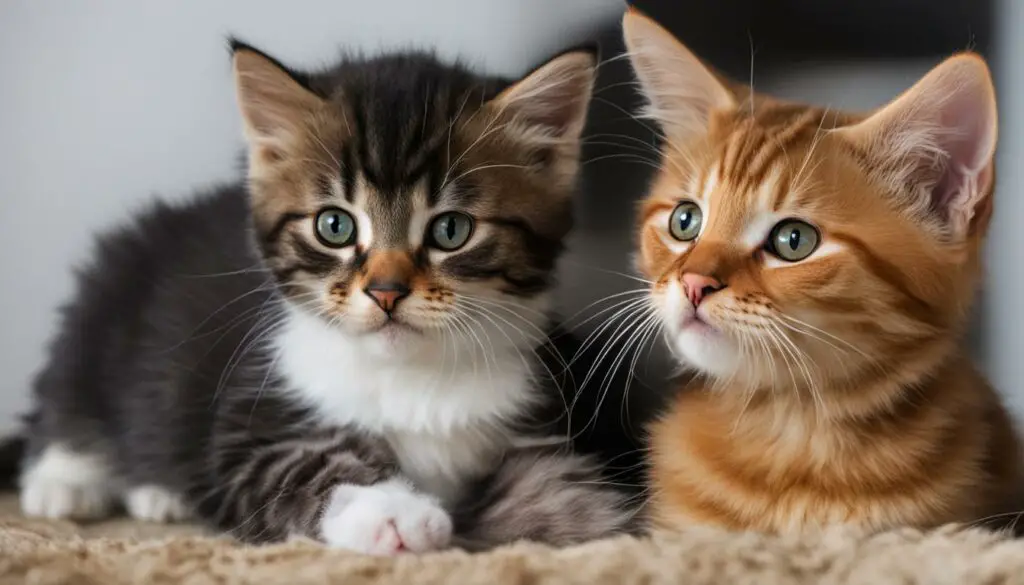
Will My Cat Eventually Stop Hissing at the Kitten?
As the introduction process between your older cat and the new kitten progresses, you may wonder if the hissing behavior will eventually cease. The good news is that in most cases, cats will indeed stop hissing at the new kitten over time. As they become more familiar with each other and establish a routine, the hissing behavior should diminish.
However, it’s important to remember that each cat is unique, and the timeline for adjustment can vary. Some cats may require more time and patience to become fully comfortable with the new addition. It’s essential to continue practicing cat socialization techniques and providing a supportive environment to facilitate a smooth transition.
If the hissing behavior persists or escalates into aggression, it’s recommended to seek advice from an animal behaviorist. They can provide personalized guidance and techniques to address any underlying issues or challenges in the cat-to-kitten introduction process.
| Benefits of Cat Socialization Techniques | Techniques for Successful Cat Introduction |
|---|---|
|
|
Remember, patience is key when it comes to cat socialization. By creating a safe and positive environment for both your older cat and the new kitten, you can help facilitate a peaceful coexistence. With time and the right approach, your cat’s hissing behavior is likely to diminish as they become accustomed to the presence of the new kitten.
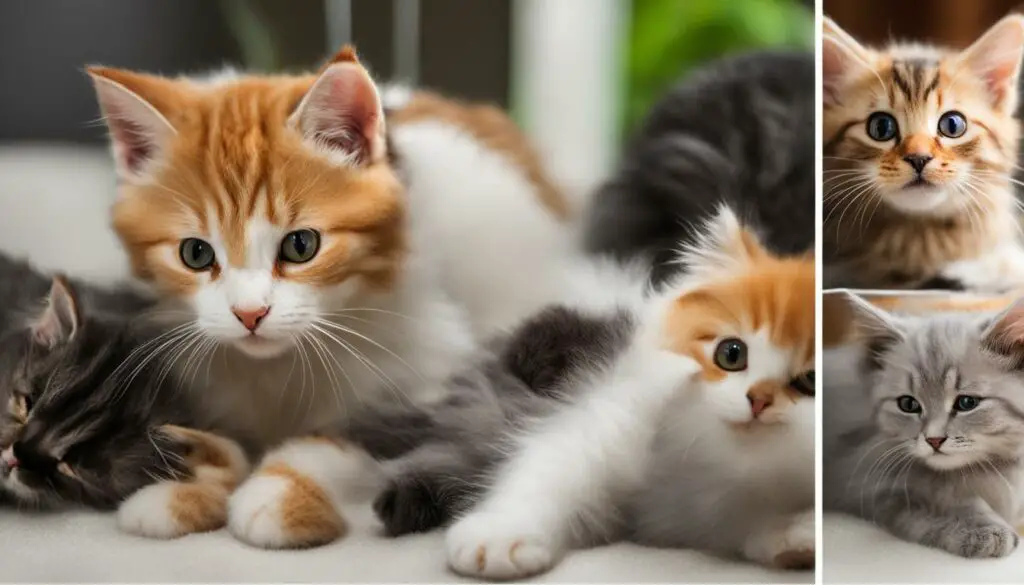
By implementing cat socialization techniques and seeking professional advice when necessary, you can ensure a successful integration of your older cat and the new kitten. Creating a harmonious environment where they can coexist peacefully is not only beneficial for their well-being but also for your own enjoyment as a cat owner.
Do All Cats Hiss at Kittens?
Not all cats will hiss at kittens, but it is not uncommon behavior. Some cats may be more tolerant and accepting of new kittens, while others may take longer to adjust. Understanding your cat’s personality and past experiences can help anticipate their reaction to a new kitten.
If your cat does hiss at the new kitten, it’s important to remember that this is often a normal part of the adjustment period. Cats are territorial creatures, and the introduction of a new kitten can disrupt their established routine and hierarchy. The hissing behavior is a way for the older cat to establish boundaries and communicate their discomfort.
However, with proper introduction techniques, patience, and time, most cats will eventually adjust and tolerate the presence of a new kitten in the household. It’s crucial to provide separate resources for each cat, such as litter boxes, food bowls, and resting areas, to minimize competition and potential conflicts. Gradually increasing supervised interactions and rewarding positive behavior can also help foster a harmonious relationship between your older cat and the new kitten.
The Importance of Patience and Socialization
Every cat is unique, and the time it takes for them to adjust to a new kitten can vary. Some cats may only hiss for a short period before accepting the new addition, while others may take weeks or even months. It’s important to be patient and allow your cats to acclimate to each other at their own pace.
Additionally, proper socialization techniques can play a crucial role in helping your cats overcome any initial hissing or discomfort. This includes gradually increasing their interactions, using positive reinforcement, and providing plenty of mental and physical stimulation for both cats. Seeking advice from an animal behaviorist can also be beneficial if the hissing behavior continues or escalates into aggression.
| Cat Behavior Towards Kittens | Explanation |
|---|---|
| Hissing | This is a common behavior observed in older cats when introduced to a new kitten. It is a way for the older cat to establish boundaries and communicate their discomfort. |
| Territorial Aggression | Cats are territorial creatures, and the introduction of a new kitten can disrupt their established routine and hierarchy. They may display territorial aggression towards the new kitten. |
| Establishing Hierarchy | Older cats may hiss at kittens to establish their dominance and hierarchy within the household. This behavior is a way for them to communicate their seniority and assert their position. |
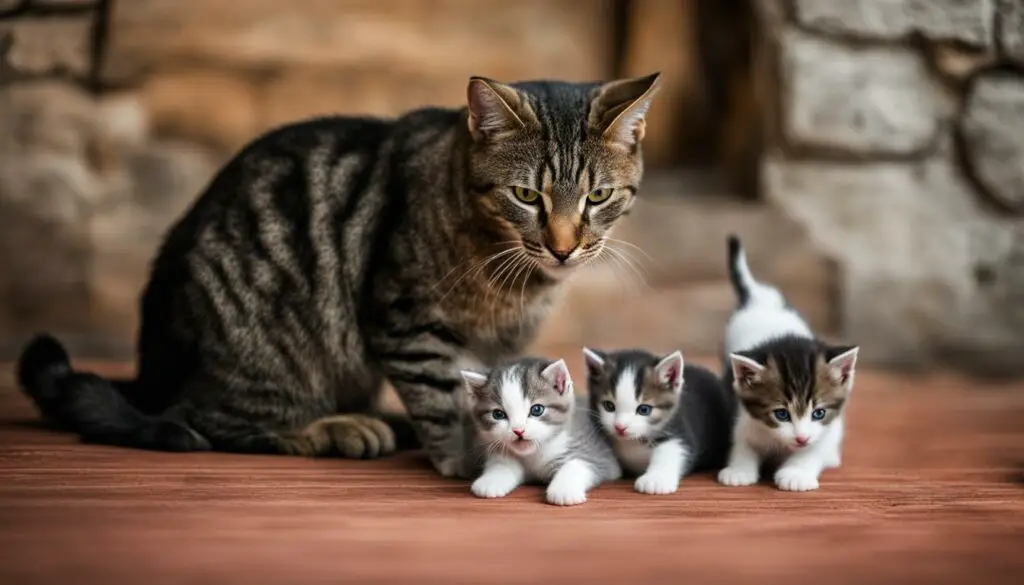
“Introducing a new kitten to your older cat can be a process that requires patience and understanding. Hissing is a normal part of this adjustment period, especially for territorial and independent cats. By following proper introduction techniques, providing separate resources, and giving both cats time to acclimate, you can create a harmonious environment where they can coexist peacefully.” – Professional Cat Behaviorist
How To Get Your Cat Used to a New Kitten
Introducing a new kitten to your cat can be an exciting yet challenging process. To ensure a smooth transition and promote positive interactions between the two, it’s important to follow some cat introduction tips and utilize effective cat socialization techniques.
Firstly, create a separate space for the new kitten initially. This allows your older cat to become familiar with the sounds and scents of the newcomer before direct interaction. Provide each cat with their own food, water bowls, litter boxes, and sleeping areas to establish their territories.
Once the initial separation period is over, gradually increase supervised interactions between the two cats. Start by allowing them to sniff each other through a cracked door or a gated area. Gradually introduce them to each other’s presence without forcing direct contact.
During the introduction process, reward both cats for calm and friendly behavior. Use treats, verbal praise, and playtime to reinforce positive interactions and help them associate each other’s presence with positive experiences.
| Key Tips for Introducing a New Kitten: |
|---|
| Prepare a separate space for the new kitten initially |
| Gradually increase supervised interactions |
| Reward positive behavior with treats and praise |
| Provide each cat with their own resources |
By following these cat introduction tips and utilizing appropriate cat socialization techniques, you can help your older cat get used to a new kitten. Remember to be patient and give both cats time to adjust to each other’s presence. Seeking advice from an animal behaviorist may also be beneficial if you encounter any challenges during the introduction process.

Cats Need Time To Adjust
Introducing a new kitten to your older cat requires patience and understanding. Cats are territorial by nature and may initially hiss at the new addition. It’s important to remember that this behavior is normal and can be managed through proper cat socialization techniques. By giving both cats time to adjust, you can create a harmonious environment where they can coexist peacefully.
During the introduction period, it’s crucial to provide separate spaces and resources for each cat. This allows them to establish their territories and reduces the likelihood of territorial aggression. Each cat should have their own bed, litter box, food, and water bowls. This helps alleviate any feelings of competition and creates a sense of security for both cats.
Gradual introduction and supervised interactions are key to successful cat socialization. Start by allowing the cats to become familiar with each other’s scents and sounds before introducing them directly. Gradually increase their interactions under supervision, rewarding positive behavior with treats or playtime. It’s important to closely monitor their interactions and intervene if the hissing escalates into aggressive behavior.
Key Takeaways:
- Introducing a new kitten to an older cat requires patience and understanding.
- Provide separate spaces and resources for each cat to establish territories and prevent conflicts.
- Gradually introduce the cats and reward positive behavior with treats or playtime.
- Monitor their interactions closely and intervene if the hissing escalates into aggression.
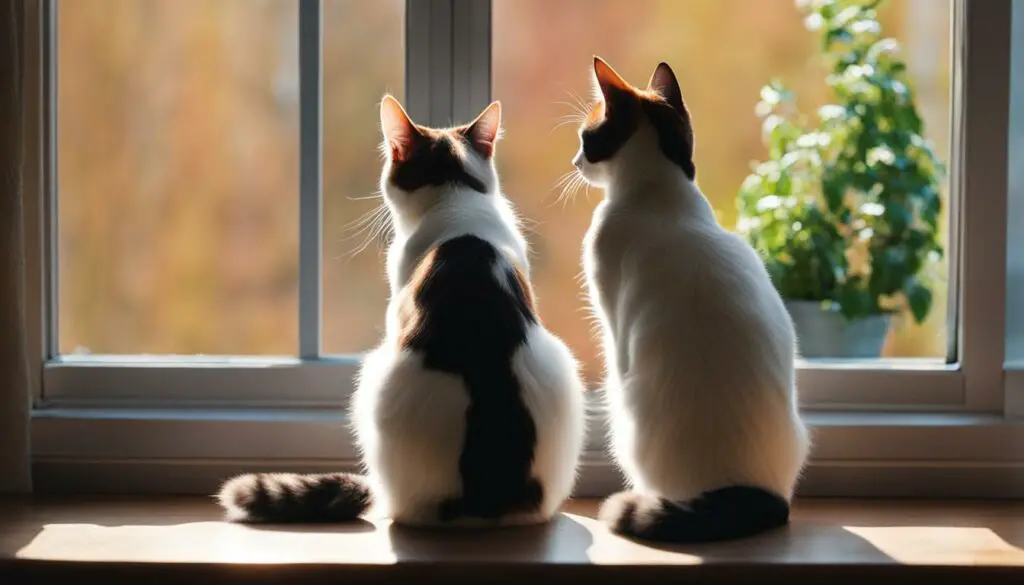
| Older Cat | New Kitten |
|---|---|
| Established territory | Unfamiliar environment |
| Experience with other cats | No prior interactions with older cats |
| May feel threatened by the new addition | Curious and eager to explore |
Giving Your Older Cat Attention
When introducing a new kitten to your older cat, it’s important to make sure your older cat still feels loved and valued. Giving them attention and reassurance during this transition period can help alleviate any feelings of jealousy or insecurity. Here are some tips for giving your older cat the attention they need:
- Spend quality one-on-one time with your older cat. Engage in activities they enjoy, such as playtime or grooming sessions.
- Provide plenty of petting and affection. Show appreciation for their presence and make them feel special.
- Offer treats or special toys as rewards for good behavior or calm interactions with the new kitten.
Remember, your older cat may feel a bit overwhelmed or stressed by the presence of the new kitten. By giving them extra attention, you can help create a sense of security and reassure them that they are still an important part of your family.
By making an effort to give your older cat attention, you can help ease their transition and foster a positive relationship with the new kitten. Remember, each cat is unique, and the adjustment period may vary. Be patient and understanding, and seek professional advice if needed. With time and proper attention, your older cat and the new kitten can coexist happily in your home.
Tips for Giving Your Older Cat Attention:
- Spend one-on-one time engaging in activities your older cat enjoys.
- Show plenty of affection through petting and cuddling.
- Offer treats or special toys as rewards for good behavior.
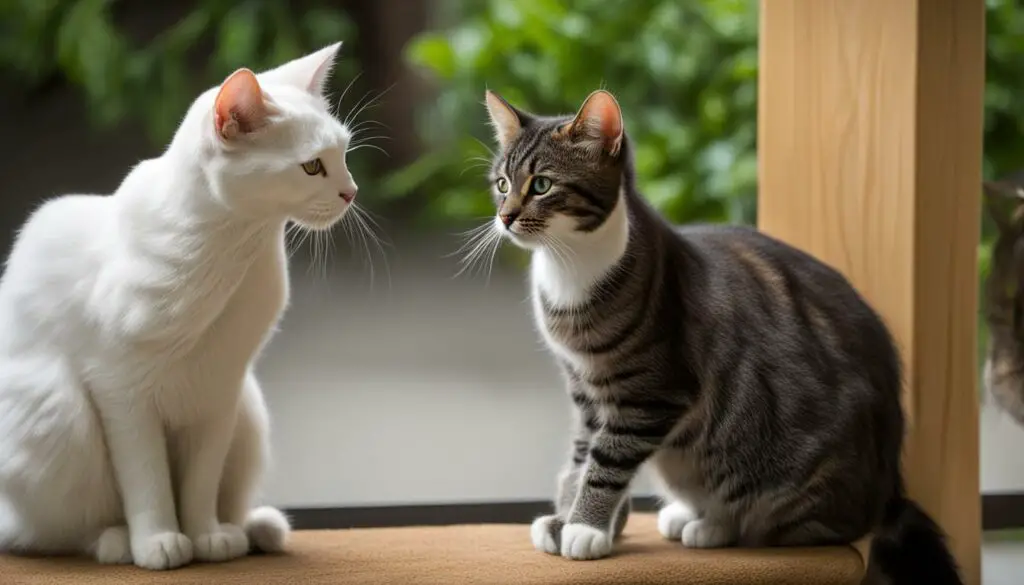
Providing Separate Resources
When introducing a new kitten to your older cat, it’s crucial to provide each cat with their own resources. This helps prevent competition and potential conflicts, allowing them to establish their territories and feel secure in their own spaces. Here are some essential resources to consider:
Litter Boxes:
Provide one litter box per cat, plus an extra one. Cats are territorial animals, and having their own designated litter box can help reduce stress and eliminate marking behavior. Place the litter boxes in separate areas of the house to ensure privacy.
Food and Water Bowls:
Each cat should have their own set of food and water bowls. This prevents food guarding and allows both cats to eat and drink at their own pace. Place the bowls in separate locations, preferably far apart, to avoid potential confrontations.
Beds and Hiding Spots:
Offer comfortable beds and hiding spots for each cat. Cats appreciate having a cozy place to retreat to when they need some alone time or want to feel secure. Provide multiple options throughout your home to accommodate both cats’ preferences.
Toys and scratching posts:
Ensure that each cat has access to toys and scratching posts. This helps redirect their energy and provides an outlet for natural behaviors. Having separate toys and scratching areas prevents competition and encourages individual play and exercise.
By providing separate resources, you can promote a peaceful coexistence between your older cat and the new kitten. Remember to observe their interactions and make any necessary adjustments to ensure both cats feel comfortable and secure in their shared environment.

Cat Introduction Tips and Socialization Techniques
Introducing a new kitten to your older cat can be an exciting but challenging process. To ensure a smooth transition and foster a positive relationship between the two, it’s important to follow some cat introduction tips and utilize effective socialization techniques.
Creating Separate Spaces
When bringing a new kitten home, provide each cat with their own designated space. This allows them to establish their territories and feel secure. Offer separate beds, litter boxes, food, and water bowls to avoid competition and potential conflicts. Creating a calm and comfortable environment for both cats promotes a sense of safety and reduces the likelihood of territorial aggression.
Gradual Introductions
Introduce the cats gradually and under supervision. Begin by allowing them to sniff and investigate each other’s scents through a cracked door or a baby gate. Gradually increase their interactions, always monitoring their behavior. If any signs of aggression or excessive hissing occur, separate them and give them more time to adjust. Remember, patience is key during the introduction period.
Positive Reinforcement
Use positive reinforcement to reward your cats for calm and friendly interactions. Offer treats, verbal praise, or playtime when they exhibit appropriate behavior. This helps create positive associations between the cats and reinforces their bond. By rewarding good behavior, you encourage them to continue building a harmonious relationship over time.
| Benefits of Cat Introduction Tips and Socialization Techniques | Examples |
|---|---|
| Promotes a peaceful cohabitation | Reduced aggression and stress between cats |
| Facilitates the establishment of a hierarchy | Clear boundaries and peaceful interactions |
| Fosters a positive bond between the cats | Cuddling, grooming, and playing together |
Remember, every cat is unique, and the introduction process may take time. Be patient and understanding as your cats adjust to each other’s presence. Professional advice is available if needed, and with consistent efforts, your cats will likely form a strong and harmonious relationship over time.
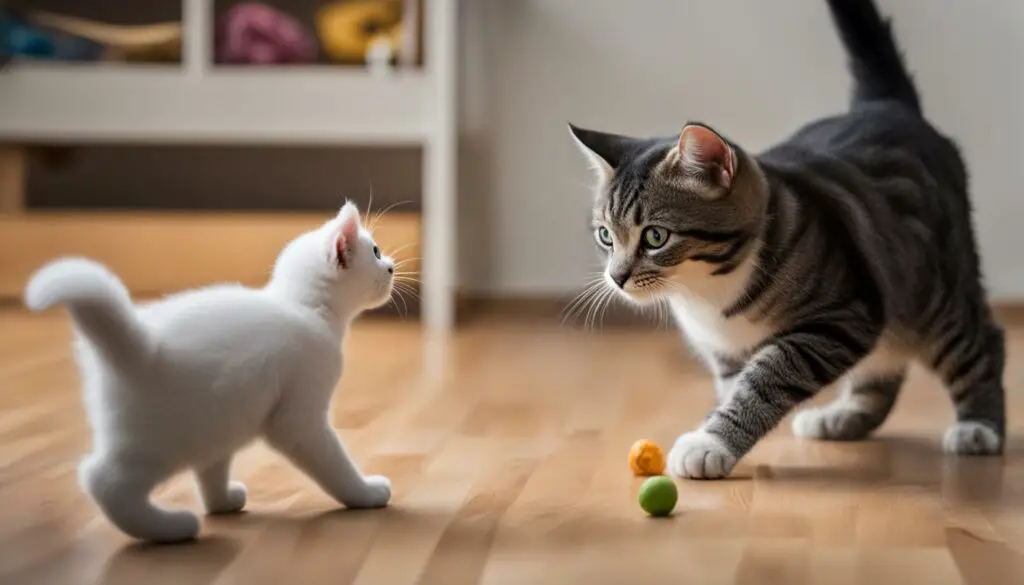
Cat Socialization Techniques and Behavior Towards Kittens
Introducing a new kitten to your older cat can be an exciting but challenging process. Socialization is key to ensuring a harmonious relationship between the two. By using effective techniques, you can help your cats adjust and build a strong bond. Here are some cat socialization techniques to consider:
Gradual Introductions
Allow your older cat and the new kitten to become familiar with each other’s scents before face-to-face interactions. Start by keeping them in separate rooms and swapping their bedding or using a pheromone diffuser to create a calming environment. Gradually introduce supervised interactions, initially through a crack in the door or a baby gate. This gradual approach helps prevent overwhelming your older cat and reduces the chances of aggression or hissing.
Positive Reinforcement
When your cats have successful interactions, reward them with treats, praise, or playtime. Positive reinforcement encourages positive associations and helps build trust between your cats. By rewarding calm and friendly behavior, you reinforce the idea that being around the new kitten brings positive experiences. This technique is especially effective in encouraging your older cat to accept the presence of the kitten.
Separate Resources
Providing separate resources for each cat, such as food bowls, water bowls, litter boxes, and resting areas, is essential. This allows them to establish their territories and reduces potential conflicts over resources. Ensure that each cat has access to necessary amenities in separate locations to avoid unnecessary competition or stress.

Using these cat socialization techniques can help ease the transition for both your older cat and the new kitten. Remember that patience and consistency are key, as every cat is unique and may require different amounts of time to adjust. With proper socialization, you can create a peaceful and loving environment where your cats can thrive together.
Seeking Professional Advice
Introducing a new kitten to your older cat can be a complex process that requires patience and understanding. While some hissing during the adjustment period is to be expected, persistent or escalating hissing may require professional intervention. Seeking advice from an animal behaviorist can provide valuable insights and strategies to address any underlying issues or challenges that may be contributing to the hissing behavior. An expert can assess the unique dynamics between your cat and the kitten, offer personalized guidance, and help ensure a successful introduction.
Professional advice can be particularly helpful if the hissing continues despite your best efforts, or if it escalates into aggressive behavior. An animal behaviorist can help you identify potential triggers, develop a tailored plan for socialization and integration, and address any territorial or hierarchical issues that may be impacting the cats’ relationship. With their expertise, you can navigate the introduction process more effectively and create a harmonious environment for both cats to coexist peacefully.
Remember that seeking professional advice is not a sign of failure, but rather a proactive step to ensure the well-being of your cats. It demonstrates your commitment to their happiness and can ultimately lead to a more positive and successful outcome. So, if you’re struggling with your cat’s hissing behavior towards the new kitten, don’t hesitate to reach out to an animal behaviorist for guidance and support.
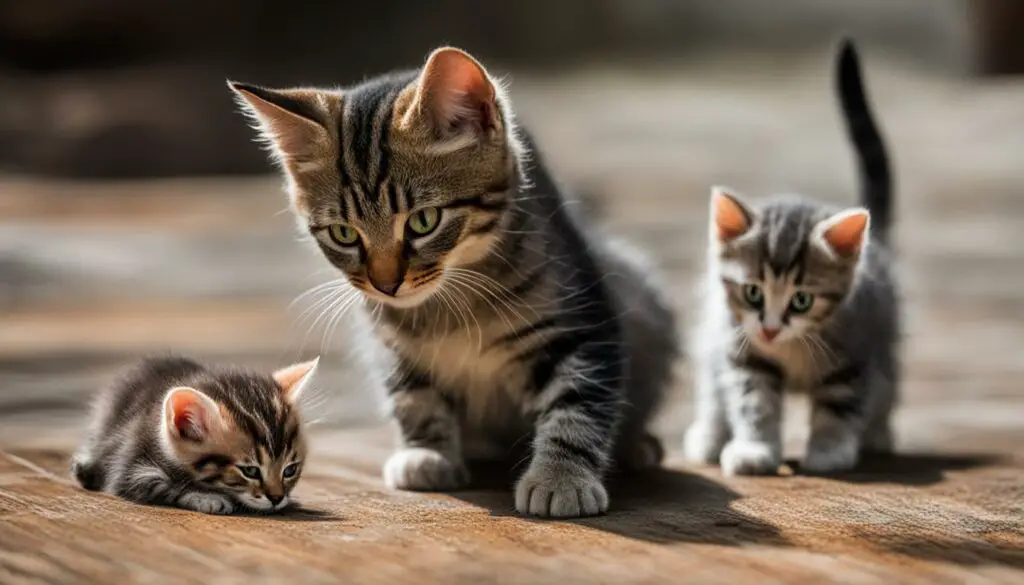
When to Seek Professional Advice:
- If the hissing persists despite gradual introductions and supervised interactions.
- If the hissing escalates into aggressive behavior or physical attacks.
- If the cats are unable to establish a peaceful coexistence after a reasonable adjustment period.
Benefits of Professional Advice:
- Expert assessment of the cats’ behavior and dynamics.
- Personalized guidance and strategies for introducing the new kitten.
- Identification and resolution of underlying issues or triggers.
- Development of a tailored plan for socialization and integration.
- Support and guidance throughout the adjustment process.
| Professional Advice for Cat Introductions | Benefits |
|---|---|
| Expert assessment of the cats’ behavior and dynamics. | Insights into potential challenges and solutions. |
| Personalized guidance and strategies for introducing the new kitten. | Increased chances of a successful integration. |
| Identification and resolution of underlying issues or triggers. | Improved understanding of the cats’ behavior. |
| Development of a tailored plan for socialization and integration. | Clear roadmap for the introduction process. |
| Support and guidance throughout the adjustment process. | Reassurance and assistance during challenging times. |
Conclusion
Introducing a new kitten to your older cat requires patience and understanding. It’s common for cats to hiss at kittens, even if they are not attacking. This behavior is often due to territorial instincts and the need to establish hierarchy. By following cat introduction tips and using cat socialization techniques, you can help your cats adjust and create a harmonious home.
Remember to provide each cat with their own space and resources, such as separate beds, litter boxes, and food bowls. Gradually increase their supervised interactions and reward positive behavior with treats and praise. Patience is key, as it may take some time for your older cat to fully accept the new kitten.
If the hissing persists or becomes aggressive, it’s important to seek professional advice from an animal behaviorist. They can provide personalized guidance to address any underlying issues and ensure a smooth transition for both cats. With time and proper introduction techniques, your cats are likely to form a bond and coexist peacefully.
FAQ
Why do cats hiss in the first place?
Cats hiss to communicate various emotions, such as annoyance, pain, or feeling threatened. It is a warning signal to back off and give them space.
Why is my cat hissing at my new kitten?
Cats may hiss at new kittens due to territorial instincts, establishing hierarchy, and feeling trapped or overwhelmed by the new addition.
What should I do if my cat starts hissing at my kitten?
It’s important to give each cat their own space and time to adjust. Provide a safe place for both cats to retreat to and gradually introduce them under supervision. Seek professional advice if the hissing persists or becomes harmful.
How long will my cat hiss at my kitten?
The duration of the hissing behavior can vary, but it may take a few weeks for an older cat to become fully comfortable with a new kitten. Seek professional advice if the hissing continues beyond this period.
How can I stop my older cat from hissing at the kitten?
Provide each cat with separate spaces, gradually increase their supervised interactions, and reward positive behavior. Giving your older cat breaks from the kitten’s presence can also help alleviate stress or annoyance.
Will my cat eventually stop hissing at the kitten?
In most cases, cats will adjust and stop hissing at the new kitten as they become more familiar with each other. However, if the hissing persists or becomes aggressive, seeking advice from an animal behaviorist is recommended.
Do all cats hiss at kittens?
Not all cats will hiss at kittens, but it is not uncommon behavior. Some cats may be more tolerant and accepting, while others may take longer to adjust.
How can I get my cat used to a new kitten?
Introduce the new kitten gradually and with patience. Provide separate spaces, increase supervised interactions, and use positive reinforcement to reward calm and friendly behavior.
Why do cats need time to adjust?
Cats need time to adjust to a new kitten’s presence and establish a routine. Rushing the process can lead to stress and potentially aggressive behavior.
How can I give my older cat attention during the introduction process?
Show appreciation for your older cat’s presence, give them plenty of attention and reassurance, and provide treats or special activities to make them feel valued.
How can I provide separate resources for my cats?
Ensure that each cat has their own beds, litter boxes, food, and water bowls. This allows them to establish their territories and reduces the likelihood of territorial aggression.
How should I monitor interactions and intervene if necessary?
Closely monitor the interactions between your older cat and the new kitten. If hissing escalates into aggressive behavior, intervene and separate them to prioritize their safety and well-being.
How can I use positive reinforcement and rewards during the introduction process?
Offer treats, verbal praise, or playtime to reinforce calm and friendly interactions. This helps create positive associations between the cats and encourages them to form a bond.
When should I seek professional advice?
If your efforts to introduce the new kitten are not successful, or if the hissing persists or becomes harmful, seeking advice from an animal behaviorist is recommended.
How can I help my cat adjust to a new kitten?
By following proper introduction techniques, providing separate resources, and giving both cats time to acclimate, you can create a harmonious environment where they can coexist peacefully.
Source Links
- https://cats.com/cat-hissing-at-new-kitten
- https://www.untamedcatfood.com/blogs/cat-care/cat-hissing-at-new-kitten
- https://www.catchat.org/felineforum/viewtopic.php?t=8090

